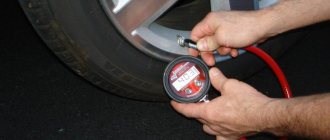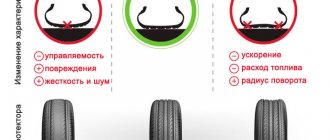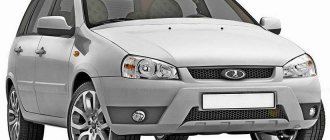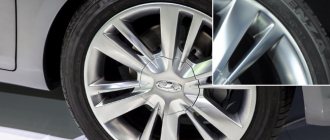Tire pressure Lada Vesta
If you don’t know what pressure is in the Lada Vesta tires, then this article will answer your question.
Please note that it is necessary to check tire pressure quite often, as this directly affects driving safety. Manufacturers also set standards for each specific car so that the driver has something to focus on.
The Lada Vesta instruction manual contains the following values:
| Vehicle modification and execution | Tire size with load capacity and speed indexes* | Wheel size | Air pressure in tires front/rear, MPa (kgf/cm2) | |||
| Rim width (inches) | Rim offset (et)**, mm | Partial load*** | Full load**** | |||
| Installed by the manufacturer | ||||||
| "sedan" version | All modifications | 185/65r15 88h 195/55r16 91h | 6j | 50 | 0,21/0,21 (2,1/2,1) | 0,2/0,22 (2,1/2,1) |
| Allowed to be installed during operation | ||||||
| "sedan" version | All modifications | 185/65R15 88T, H 195/55R16 87.91T, H | 5J, 5½J, 6J 5½J, 6J, | 50 | 0,21/0,21 (2,1/2,1) | 0,21/0,21 (2,1/2,1) |
* Speed indices: T – up to 190 km/h, H – up to 210 km/h. Load capacity indices: 88–560 kg; 91–615 kg. **Rim offset (ET) is the distance from the mating plane of the disc to the middle of the rim. *** Partial load – no more than 3 adults in the car without cargo in the trunk. **** Full load – more than 3 adults or 3 adults and a load of 50 kg in the trunk.
Deviation from these recommendations will lead to dire consequences:
- The stability and controllability of your car will deteriorate;
- Fuel consumption will increase due to greater tire resistance;
- Tire wear will increase.
If you don’t want to memorize the table, then on the Lada Vesta the recommended tire pressure values are indicated on a special information plate, which is located on the B-pillar on the driver’s side. Just open the driver's door and find out the recommended tire pressure for the Lada Vesta.
If the pressure constantly drops, then it is necessary not only to pump up the tires, but to eliminate the source of the leak. First of all, you should check the spool; if it is working, then the problem is in the tires or wheels. You may have a puncture or a loose fit between the tire and the rim.
Note that the air pressure in tires is constantly changing, depending on the temperature of the air inside the tire. At low temperatures, air compresses and pressure drops; as temperature rises, pressure increases. It is optimal to check the readings at an ambient temperature within 10-15 degrees Celsius and after a short period of inactivity. When driving, the tires warm up, so measuring the pressure immediately after a trip is incorrect.
What is the tire pressure in a Lada Vesta car: technical parameters
Decreased performance results in:
- tires wear out much faster;
- the car becomes poorly controlled, which is especially noticeable in icy conditions or on wet roads;
- resistance increases, which leads to a significant increase in the amount of fuel consumed.
Increased performance is one of the main reasons for accelerated wear of a car's suspension, although the vehicle's driving characteristics are improving.
Thus, the lack of normal tire pressure affects both the safety of the driver and his passengers, and the financial condition of the car owner.
Lada Vesta
The pressure in the Lada Vesta tires is the same front and rear. The values for various modifications are presented in the table below.
| Tire radius | Pressure at partial load, MPa | Pressure at full load, MPa |
| 15 radius | 0,21 | 0,22 |
| 16 radius | 0,21 | 0,22 |
Partial load means that the machine is not fully loaded, that is, only
There is only one driver and two passenger seats, and the trunk contains a load of less than 50 kg.
Full load means more than three adults in the car and/or a trunk load of more than 50 kg.
These values do not have to be memorized - they are written in the information table located in the car body on the driver's seat side, that is, you just need to look at the table to be sure that the values being set are correct.
How often to measure
Please note that pressure readings undergo significant changes when the air temperature changes in winter and summer, gradually during movement, and also during movement when heated. The general rule is that it is necessary to take measurements before a trip only if the car has had time to cool down after previous use. If you measure this value immediately, it will turn out to be overestimated, because an increase in air temperature inevitably leads to an increase in pressure.
A mandatory check is carried out when the ambient temperature changes by 10-15 degrees. In addition, if you notice that the “behavior” of the car has changed, it has become difficult to drive, then first of all it is recommended to check the tire pressure and restore it if necessary.
Lada Vesta tire pressure in summer
Many people know about the need to check tire pressure. If there is a discrepancy, the tires wear out faster, stability is lost, and the fact of inflated or flat tires affects handling and fuel consumption. Monitor the pressure, like any part of the car, tires need careful care and inspection. Familiarize yourself with the load capacity and speed indices and find out what parameters the tires of your car have. Let's figure out what the tire pressure should be on a Lada Vesta.
What wheels can still be installed on the Lada Vesta SV Cross?
In search of wheels for the Lada Vesta SV Cross, I went to our local online store “Siberia Wheel”. I entered the parameters I needed and got the assortment I needed. The site gave me 10 different alloy wheels that will fit the Vesta and that you can buy:
There are not many manufacturers, namely only 4 - NZ, Proma, PDW and LS. But you can choose something.
For example, I liked the Proma Tsunami diamond matte wheels:
I would most likely take these for myself if there were no other options. The car would definitely be transformed with them, and the price for the disc is not bad. RUR 4950 per piece, delivery time 7-10 days. The price is quite reasonable, and the wait time is not very long.
To reliably protect the body from dirt and chips, we recommend! Photo of Lada Vesta SV in Pluto color, which looks great even without any tuning.
Not long ago sales of the station wagon started. In principle, this model is very much reminiscent of modern foreign vehicles, which is good news. One of the distinctive characteristics of this off-road vehicle is the huge seventeen-inch alloy wheels. As a result, the car requires special tires. We’ll talk about choosing tires for you now.
It is worth noting that car tires play a very important role. This element affects such parameters as:
- maximum speed and acceleration of the car;
- controllability and braking distance;
- amount of fuel consumed;
- wear of the chassis, etc.
Thus, it is very important to carefully select tires, and also use only those tires that are provided by the manufacturer.
How often to measure to kill rubber
Please note that pressure may change due to changes in ambient temperature. Moreover, the process occurs equally in winter and summer. The main rule when checking is to measure it before driving, before the tires get hot. After a short trip, the wheels become very hot and the performance differs significantly from the real ones.
Measurements should be taken not only after tire wear has become noticeable. The manufacturer recommends checking the inflation when you feel that the car is behaving differently. For example, it began to throw to the sides, uncertainly when entering turns. In any operating book you will find information that a check must be carried out if temperature changes reach 10-15 degrees. As a rule, these are the spring/autumn seasons, be careful this is a time of temperature fluctuations.
What kind of pressure should you keep in the tires on Vesta?
Tire pressure on Vesta is regulated both by the factory and by the driver independently, depending on the operation of the tires. What is the pressure of R15, taking into account the standard size 185/65 (tire) 88H and offset (rim width) 50 mm - 2.1 at partial and 2.2 atmospheres at full load. Taking into account the standard size 195/55 R16 91H with an offset of 50 ET - 2.1 and 2.2 “atmospheres”, at partial and full load, respectively.
For the winter
Lada Vesta tire pressure for winter recommended by the manufacturer depends on the size of the wheel and tires, it must exceed the norm + 0.1 MPa. In summer, for example, for R16 2.1 atmospheres, in winter 2.2 atmospheres are better due to frost.
For summer
The situation is similar with summer “sneakers”, but here we argue on the contrary, taking into account the increased temperature, it is better to reduce the pumping to -0.1 atmospheres. This difference will compensate for the thermal contraction or expansion of air in the wheel.
Lada Vesta tire size
The manufacturer installs tires of two sizes on the Lada Vesta car:
- 185/65/R15
- 195/65/R16
195/65/R16 tires are installed on 16-inch alloy wheels, and 185/65/R15 tires are installed on 15-inch wheels, which you can see in the photos above. In its recommendations for choosing tires for Vesta, the plant also did not distinguish itself with originality and offered the options already mentioned above. However, for those who want to install larger tires on their car, for example, size 205/55/R16, there will be no disappointments, because the tire also easily fits into the right place and does not catch anything. Experimenting with larger sizes is not recommended.
How many atmospheres to pump the wheels on the Lada Vesta Cross - instructions
The factory recommendation for Vesta Cross indicates from 2.2 to 2.4 “atmospheres”, this also depends on driving style. The size plays a role, considering that the manufacturer installs R17 wheels and size 205/50. Some people want a higher, wider tire, so they “play” with the inflation level as they want. But, you need to take into account all the features, what the load is, the diameter, the larger the diameter, the smaller the height. It is generally accepted that for the Cross version the average values range from 2.2 to 2.4 atmospheres.
Standard tire pressure monitoring system on Lada Vesta
At the moment, this system is available - it is installed on export versions of the Lada family: Vesta, XRay, Kalina, Granta. It’s hard to say when the option will appear on Lada models intended for Russia; the fact that the option is available is encouraging. Perhaps soon the “gadgets” will be available here too.
Taking into account the equipment of export vehicles, their “tidy” is also different, because this is where information from the sensors is sent. In general, the TPMS tire pressure monitoring system is represented by four built-in sensors in the wheel valves. TPMS sensors regularly measure and send data to the dashboard, informing the driver.
Vesta tire pressure sensor
A tire pressure sensor is not installed on Vesta. Export Lada cars have a sensor, so in the future, it may appear on LADA Vesta as an option.
Tires are an integral part of the car; their presence, in principle, is not questioned, because without them the car will not go anywhere.
However, tire quality has become one of the most popular topics of discussion among car enthusiasts. In addition to brands, car tires have much more informative parameters. Almost every car enthusiast has noticed a similar inscription on his new tires - 185/65/R15, but not everyone understands what this notation means and how to navigate it. The first number, in our case 185, is responsible for the width of the tire and informs its owner that it is equal to 185 millimeters, the second number 65 is the ratio of the profile height to the width, which is indicated as a percentage. The letter R in the size entry indicates that the tire belongs to the family of radial tires. Well, the last number 15
indicates that the tire fits rims of 15 diameter (indicated in inches).
What indicators depend on tire pressure
The following indicators depend on the air in the tires:
- Maneuverability;
- Controllability;
- Road grip;
- Fuel consumption;
- Cross-country ability - if you want to drive off-road, lower the tires.
Uninflated wheels can cause disc damage. Imagine you are driving on a road where the surface is not ideal. We drove through the pit, taking into account the weak pumping, the disk takes more load. For steel rims there is practically no problem, but “casting”, titanium rims, can not only bend, but crack. And the impact on the tire is no less.
It is enough just to look at the photo, as we see with different pumping, the surface of contact between the wheel and the road changes. This is why some areas wear out quickly, while others do not interact at all. Insufficient traction can cause an accident.
If you think pumping is not a problem, you are mistaken. Over-inflated tires are dangerous, increasing the risk of aquaplaning and similarly, the contact plane is smaller, causing uneven wear.
In conclusion, I would like to say, monitor the pressure, maintain it as required by the manufacturer. Pay attention to your own driving preferences. Fans of high-speed driving can deviate from the average by 0.1 bar. After all, at speed, the temperature rises, and accordingly the pressure, which is why an excess of the latter often leads to rupture of the rubber - be careful on the roads!
Tire care
In general, caring for Lada Vesta tires is no different from other car manufacturers - it is not recommended to drive on roadsides, untested roads, or off-road, especially at high speed.
Additionally, the Lada Vesta manufacturer advises periodically swapping the front and rear tires so that their wear is approximately equal. This measure can significantly extend the service life of the rubber.
Hello everyone, here are the tire pressure sensors. Everything looks good and of high quality.
There is nothing complicated in the installation, 700 rubles at a tire shop, and the sensors are in place. We stood up as if we had been standing there all our lives.
The receiver detected the sensors in the wheels while they were still in the tire shop, everything works clearly, the pressure is shown correctly, the low pressure warning is set to 1.9 bar, the receiver goes to sleep due to inactivity, and wakes up when it senses vibration, the sensors in the wheels also fall asleep when inactive wake up two meters after the start of movement
I was very pleased with these sensors, I drove 200 km with them, everything is fine =) I also bought a recorder from China, with the ability to connect via wi-fi and watch videos directly from my phone
And a toy came for reading errors =)
Answers (2)
The manufacturer recommends inflating tires with dimensions 185/65R15 and 195/55R16 to 2.1 bar, both front and rear. This is indicated in the instruction manual and on the plate.
If it suddenly seems that the wheels are too hard, then you can reduce it to 2.0 bar, but you should not reduce the pressure below.
It is also worth considering seasonality and checking pressure depending on the time of year.
For example, in summer, as the temperature rises, pressure increases, and in winter, it decreases. It is not for nothing that at tire shops, before winter re-shoeing, when it is not yet completely cold, but the temperature is about to drop, tires are inflated slightly above the recommended values.
Check pressure when temperature changes and more.
Many people know how important it is to periodically check the pressure in your car tires. If the pressure does not meet the manufacturer's recommendations, the tires will wear out faster, stability and controllability on the road will deteriorate, and fuel consumption will increase. Do you know what the pressure should be in the Vesta wheels?
In the vehicle operating instructions, the manufacturer indicated the following recommendations:
| Tire size with load capacity and speed indexes* | Wheel size | Air pressure in tires front/rear, MPa (kgf/cm2) | ||
| rim width (inches) | rim offset (ET)**, mm | partial load*** | full load**** | |
| Installed by the manufacturer | ||||
| 185/65R15 88H 195/55R16 91H | 6J | 50 | 0,21/0,21 (2,1/2,1) | 0,2/0,22 (2,1/2,1) |
| Allowed to be installed during operation | ||||
| 185/65R15 88T, H 195/55R16 87, 91T, H | 5J, 5½J, 6J 5½J, 6J | 50 | 0,21/0,21 (2,1/2,1) | 0,21/0,21 (2,1/2,1) |
* Speed indices: T – up to 190 km/h, H – up to 210 km/h. Load capacity indices: 88–560 kg; 91–615 kg. **Rim offset (ET) is the distance from the mating plane of the disc to the middle of the rim. *** Partial load – no more than 3 adults in the car without cargo in the trunk. **** Full load – more than 3 adults or 3 adults and a load of 50 kg in the trunk.
How much to pump the wheels can also be found out from the plate, which is located on the central pillar of the body on the driver's side (visible when the door is open).
If you notice that the tire pressure is dropping, first check the serviceability of the valve spool. If it does not allow air to pass through, then the tire is most likely damaged; contact a tire repair shop.
Important! The air pressure in the tire is not constant. When the ambient temperature rises, the tire pressure increases, and when it decreases, it drops. You should check the pressure in Vesta tires when the temperature difference is 10-15 o C. Also, the pressure in the tire increases while the car is moving, so checking it immediately after a trip is incorrect. Wait until the tire temperature is equal to the ambient temperature.
Source: avtoplus33.ru
Winter tires on SW Cross
The developers tried to achieve a crossover effect from the standard wheelbase of this car. Winter tires on the Lada Vesta SV Cross can only be installed in 17-inch sizes, since these are the wheels that allow you to achieve a maximum ground clearance of 203 mm. The SV Cross modifications are coming off the assembly lines of automakers, having the following basic characteristics of tires installed in the standard version only for use in the summer:
- If we consider only geometric parameters, then the wheels for this modification of the Lada have the same size - 205/50/R17, which allows the car to have a decent appearance, overcome difficult sections of the road, and also not get stuck on soft ground thanks to the wide sole with powerful treads.
- When choosing winter tires for the Lada Vesta SW Cross, drivers should remember that most of these wheels are produced in an all-season version. If they need to choose a good friction or studded tire, they should still change the wheel to R16, since a 55-60 mm side cord is much more reliable when driving on rough terrain in the cold season.
- When a driver operates his car exclusively in a big city, he may well use all-season tires.
- Vesta Cross tire sizes do not offer drivers a rich assortment due to the specific technical characteristics of the vehicle. Absolutely all tires installed as standard on this modification of Vesta have special indexes.
For example, the XL marking, which means a reinforced side cord, and on such a tire the driver can safely move over sharp rocks, as well as turn at speed, without worrying about the deformation of his tires.
On the profile of the Vesta SV Cross tire you can find the abbreviation M + S, which means Mud and Snow, and translated into Russian - “dirt” and “snow”. This designation does not mean that the tire has excellent grip on the road surface at temperatures below 0 degrees Celsius, but the treads are designed in such a way that the tire has traction properties on almost any surface down to -10 degrees.
You might be interested in this About tire pressure on Daewoo Matiz and Nexia
Winter tires for Lada Vesta SW Cross
- The last important point when choosing tires for a given car is the shi indices. Considering the model’s ability to overcome areas with poor road quality, as well as the ability to accelerate to a speed of 190 km/h, these parameters in the factory version vary from 89V to 93W. These figures mean that when inflated, each wheel can withstand a load of up to 580-650 kg, and you can safely drive in this state at a speed of 240-270 km/h for at least 30 minutes without the risk of dismantling.
Important!
Despite the fact that AvtoVAZ puts on its premium models only those tires that are produced in the Russian Federation, most world-famous brands often use a size range compatible with Lada. And car enthusiasts can choose a tire to suit every taste and budget.
Test of winter tires from different manufacturers for Lada Vesta SW Cross
About tire pressure on Lada cars in summer and winter
Reading time: 6 minutes
Correct tire pressure is a very important aspect of driving safely. Although this indicator can be called relative, since it indicates the ratio of the proportion of air to volume, and does not simply measure its amount in the tire. But such measurements should be carried out constantly, because systematic monitoring will ensure driving safety and the durability of car components. Measurements are carried out using a special device called a pressure gauge. They come in different types and different accuracy classes. Therefore, for regular use it is worth choosing a high-quality device with a high accuracy class.
Recommendations from experts on the operation of winter wheels on the Lada Vesta
When using winter wheels on Vesta, according to the recommendations of experts, it is necessary to take into account a number of significant parameters:
- A Lada Vesta car may suffer from brake defects in the cold. This is noted by a number of owners and experts. We are not talking about a complete failure of the brake, but about such minor defects as a slight retraction of the brake pedal, etc. But be that as it may, in order to protect yourself, you need to purchase winter tires with good braking performance and a short braking distance.
- On a Lada Vesta, the tire pressure in winter should not be too high; it must be maintained only within normal limits.
- You should be more careful about the stabilization option when using winter tires (especially friction tires) on ice. Using stabilization on icy roads in winter can lead to deterioration in vehicle controllability.
You may be interested in this About bracelets for car wheels
Vesta on winter roads
Tire pressure "Lada Granta"
Cars from the domestic manufacturer Lada Granta are popular even today. This is because their price is low, and even an average family with an average income can afford such a car. The price-quality ratio is approximately the same, although some Lada models still receive a lot of negative reviews on the forums. Owners of such cars often do not think about what pressure standards must be observed. They don’t even know where such parameters are indicated. Similar information can be found in the instruction manual. There the manufacturer describes which indicators are suitable for which modification. Information about the tire sizes suitable for such cars and the number of atmospheres for each option are also provided.
Tire pressure gauge
In 13-inch tires, the permissible level at partial load is 1.9 atmospheres. And when fully loaded, they increase to 2.1 bar on the rear tires. But 14-inch wheels need to be inflated to 2.0 bar. At maximum load of the car, the indicators should be 2.2 Bar on the rear axle tires. The total carrying capacity of the vehicle is 475 kilograms.
Very often, employees of such organizations do not bother and pump all tires to 2.0 bar. And such indicators can be overestimated or underestimated for a particular brand of car. Therefore, the pumping should be controlled independently. A lot of problems can arise due to incorrect pressure. For example, under-inflated tires can lead to:
- quick erasing of side protectors on rubber;
- overheating of tires and their premature deterioration;
- impaired vehicle control, especially when turning;
- excessive fuel consumption.
There are some advantages to underinflated tires:
- soft running of the car;
- no noise or rattling inside the machine.
Overinflated wheels also do not have a very good effect on the condition of the components and parts of the car:
- the suspension wears out quickly;
- the middle tread on the rubber wears off;
- the car drives hard;
- You can hear a rattling sound in the cabin and feel all the bumps and potholes on the road.
The only advantage is fuel economy, but you shouldn’t be too happy about this fact. The disadvantages here clearly outweigh all the advantages.
How to choose the right winter tires for Lada Vesta SW Cross
On a note!
Not every tire will have ideal grip properties on slippery surfaces in the winter. If the car enthusiast follows the recommendations below, then he will not have any problems when operating the vehicle:
- If the driver drives his Lada exclusively in the city, then the all-season M + S version with hard treads that will not wear out quickly during sharp braking or when turning on asphalt surfaces will suit him.
- When the vehicle is operated on country roads, or in the region where the driver lives, the air temperature often drops below -10 degrees Celsius, then it is simply impossible to do without full-fledged winter tires. And it’s even better if it is equipped with multi-directional metal spikes, which will ensure the stability of the car during acceleration, braking and cornering.
- If the car is planned to be used on rough terrain with completely snowy roads, then a studded tire will be unnecessary, because the studs play virtually no role in traction, and the main function is taken over by the soft tread. Thus, a car enthusiast should purchase a friction tire, the surface of which is cut into numerous lamellas with sharp edges.
Friction tires on Lada Vesta SW Cross
These elements, when pressed on them under the weight of the car, move apart, forming dozens of cracks, into each of which snow mass falls, lingering there for a certain time.
As the wheel rotates, the traction surface increases significantly, which provides additional frictional force that pushes the car forward without slipping.
If excess moisture forms under the wheels (for example, at zero temperature outside the window, when the snow turns into mush), then it is effectively removed through special grooves for collecting water between the blocks of lamellas.
- When choosing wheels, a car enthusiast can turn not only to companies that are authorized brands of the concern, but also to other brands whose products are adapted for normal use in the middle zone. This means that the chemical composition of the rubber must be selected in such a way that the protectors do not harden even at extremely low temperatures.
You may be interested in this About tires on Audi (Audi) with factory balancing
It is advisable to select tires that contain admixtures of silicate materials and create an abrasive surface during wear. The most popular brands for Russian car enthusiasts are Nokian, Bridgestone, Pirelli, Michelin, Amtel, Viatti and some other companies that are widespread in the Russian Federation.
Important!
Before choosing a particular tire brand, a car enthusiast needs to verify their authenticity by checking the technical specifications on the tire manufacturer’s website with the data at the retail outlet.
Studded tires for Lada Vesta SW Cross
Tire pressure "Lada" in winter
In winter and summer, the pressure inside the tire changes due to environmental temperature changes. For example, in the summer, when it is very hot, the air inside the tire heats up and its volume increases. Therefore, the wheels need to be slightly underinflated, about 0.3 atmospheres. And in winter exactly the opposite happens. Due to low temperatures, the volume of air in a tire decreases, and therefore they should also be pumped at 0.3 atmospheres.
It is very important where exactly the car is located. If it is in a warm room, then when measuring pressure the pressure gauge will show optimal readings. But if you go outside in the cold, the tire performance will drop by about 0.4 Bar. And the car will already be driving on underinflated tires, and this is unsafe. Therefore, you should inflate the wheels in the garage and slightly increase the standard values, since they fall in the cold.
Fans of the Lada Kalina station wagon often do not think about changes in tire pressure at different times of the year. For such cars, the optimal indicators are 2.2 atmospheres on the wheels of the front axle, and 2.3 on the rear. Most drivers agree with these recommendations from the manufacturer and do not report severe discomfort while driving. But in winter, many people deviate from these standards. In cold weather, the front tires are inflated to 2.0 Bar, and the rear tires to 2.2 Bar. This takes into account that the tires on the car are factory. If the car is re-shod with wide-profile tires, the pressure readings increase. The front should be 2.4 Bar and the rear should be 2.5 Bar. Low-profile and narrow tires require 1.9-2.0 atmospheres on the front axle, and 2.0-2.2 on the rear.
Kalina
The Lada Vesta sedan has a greater maximum load capacity than the previous model. The load capacity index is up to 615 kilograms. The instructions indicate pressure parameters equal to 2.1 atmospheres, both for the front and rear wheels. As the load increases, the rear wheels are pumped up to 2.2 bar. Such indicators are typical for tires R15 and R16. But in winter it is better to keep the pressure within 2.2 Bar. The manufacturer recommends measuring the amount of air in the tire at least once a week. And also such an event must be carried out before a long trip.
Fans of the Largus model should know that the atmospheric performance in this car is higher than in the previous models under consideration. The pressure in Largus wheels for tires R14 and R15 is 2.4 Bar on the front axle, and 2.6 on the rear. But owners of such cars note that with such parameters the car drives very hard, so they often underestimate the recommended readings. At the same time, there is no significant wear of the rubber. But you shouldn’t get carried away with underestimation, as this can lead to a lot of problems. If the driver is a fan of fast driving, then lowering the pressure by 1.0 Bar will be quite justified. The rubber heats up at high speed, and the volume of air increases, so such a decrease will not affect it.
Lada Kalina tire pressure in winter
Elite
Posts: 4439 On the forum since: 09.15.13
Cat_Alex Victor
And this has happened, I measure it with a regular car pressure gauge (the simplest one) and it shows 1.5-1.6. I measure it with a car compressor (pump) and it shows 2.0-2.1. Pressure gauge against the wall?
User
Posts: 148 On the forum since: 09.25.13
Hi all! I have a Kalina 2 hatchback. What should be the tire pressure front and rear? Tires Kama, 14 (summer). Thank you!
Everything is explained in the instructions for the car. https://kalina2.ru. alina2.pdf Page 118.
User
Posts: 80 On the forum since: 08/16/13
Cat_Alex Victor
And this has happened, I measure it with a regular car pressure gauge (the simplest one) and it shows 1.5-1.6. I measure it with a car compressor (pump) and it shows 2.0-2.1. Pressure gauge against the wall?
Elite
Posts: 3522 On the forum since: 05/17/14
Today I saw that visually one of the front wheels seemed to be a little flat. I remembered that in winter they need to be checked periodically, so I decided to see what the pressure was in them. I checked it and was very surprised. Pressure 1.5-1.7 mark.
I pumped it up to 2 atm, now I’m calm.
It’s like the joke: the girls say you have a flat tire! she answers yes at the bottom, but no at the top.
Advanced user
Posts: 390 On the forum since: 05/17/14
The instructions say 2 atm for each wheel. if the rear is fully loaded, then 2.2 atm to the rear wheels.
I pump the front ones myself - 2.1 atm, the rear ones - 2 atm. on smooth asphalt, you can see that the front ones are pushed through more than the rear ones, at 2 atm. There is more weight in the front when the car is empty.
Tire pressure indicators for Lada Liftback in summer
The manufacturer's hint regarding optimal pressure levels can be found on the driver's door center pillar. According to it, the number of atmospheres in such a car should be 2.0 atmospheres on all four wheels with a minimum load. The maximum load of the car provides for a change in indicators to 2.2 Bar on the rear axle and 2.0 Bar on the front.
In the summer, if the car is in a cool garage, the indicators will be the same, but when the car goes out into the heat, the amount of air in the tire will increase. Therefore, before the trip it is worth lowering the pressure by about 0.3 Bar. This way you can achieve the most correct parameters as stated by the manufacturer. The most important thing in this case is to monitor the behavior of the car. If the car skids when turning or excessive fuel consumption is noticed, then you immediately need to check the pressure and bring it to optimal levels. Otherwise you will have to buy new parts and tires.
Properly inflated tires
The pressure must be checked by the driver systematically. If you constantly forget about such a little thing, it can lead to many consequences. When driving a car on a busy highway with the wrong pressure, you can endanger not only yourself, but also other drivers and pedestrians.
Source: kolesa.guru
FakeHeader
Comments 55
Where did you order the sensors? I would like a link
3700 whole set
To bookmarks! It’s very interesting how the pressure changes when driving? What are the optimal indicators for yourself? They also say that if the wheels are filled with Nitrogen, the pressure does not change due to heating.
When driving, the pressure rises by 0.1-0.2 and the temperature by about 20 degrees, in all wheels)
To bookmarks! It’s very interesting how the pressure changes when driving? What are the optimal indicators for yourself? They also say that if the wheels are filled with Nitrogen, the pressure does not change due to heating.
Did you get a C in physics/chemistry? What is the percentage of nitrogen in the air?
80))) so we need to dispel myths with this device. It's a waste of money
And they pump nitrogen not for the sake of money, but to show off











